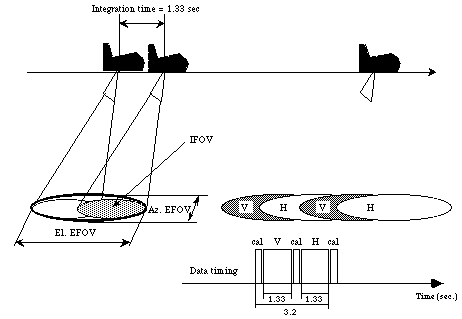Instrument
The parameter specifications of AMR are described in Table 1 for H-polarization observation. AMR is flown on a Beechcraft-B200 aircraft owned by Nakanihon Air Service Co., Ltd. under contract to NASDA/RESTEC (Remote Sensing Technology Center of Japan).
| Antenna | |
| Incidence angle (degree) | 0, 11, or 55 (fixed during flight) |
| Delta T (K) | <0.2 to 0.4 (depending on frequency) |
| Polarization | Vertical and horizontal for all channels |
| Receiver | Dicke switching receiver |
| A/D | 12 bits |
| Integration time | 1.33 sec. |
| Instrument mass | approx. 600 kg |
| Instrument power | approx. 5 kW |
| Center frequencies (GHz) | 6.925 | 10.65 | 18.7 | 23.8 | 36.5 | 89.0 |
| Bandwidth (MHz) | 350 | 100 | 200 | 400 | 1000 | 3000 |
| Beamwidth El. (3dB in deg.) | 12.3 | 10.0 | 8.9 | 6.3 | 7.2 | 7.2 |
| Beamwidth Az. (3dB in deg.) | 10.7 | 8.6 | 6.5 | 5.4 | 6.2 | 6.2 |
The Effective Field of view for each frequency band is shown in Table 2 for a case of 55 degrees incidence angle, three typical altitudes and flight speeds.
| Center Frequency (GHz) | 6.925 | 10.65 | 18.7 | 23.8 | 36.5 | 89.0 |
| Altitude=8,000 m | ||||||
| Typical flight speed=115 m/sec | ||||||
| Effective FOV (km) El. | 5.52 | 4.48 | 3.54 | 2.85 | 3.24 | 3.24 |
| Effective FOV (km) Az. | 2.61 | 2.1 | 1.58 | 1.32 | 1.51 | 1.51 |
| Altitude=3,000 m | ||||||
| Typical flight speed=90 m/sec | ||||||
| Effective FOV (km) El. | 2.13 | 1.74 | 1.39 | 1.13 | 1.28 | 1.28 |
| Effective FOV (km) Az. | 0.98 | 0.79 | 0.59 | 0.49 | 0.57 | 0.57 |
| Altitude=500 m | ||||||
| Typical flight speed=80 m/sec | ||||||
| Effective FOV (km) El. | 0.44 | 0.38 | 0.32 | 0.27 | 0.3 | 0.3 |
| Effective FOV (km) Az. | 0.16 | 0.13 | 0.1 | 0.08 | 0.09 | 0.09 |
AMR observation concept

Retern to Contents
Earth Observation Research Center
National Space Development Agency of Japan
National Space Development Agency of Japan